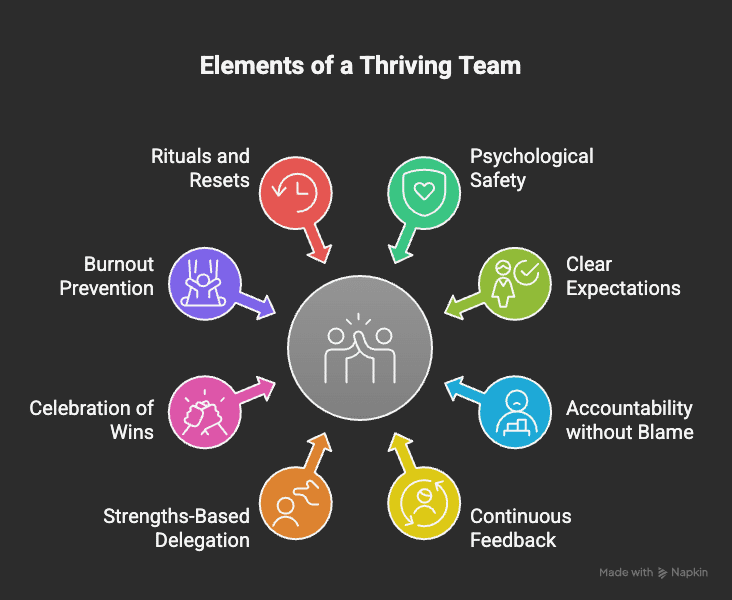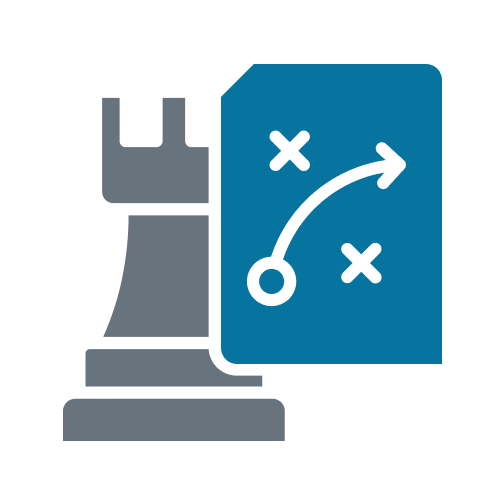How to build a strong team isn’t just a leadership cliché—it’s one of the most critical competencies a CEO can develop. In today’s climate of high turnover, remote work complexity, and generational shifts in employee expectations, knowing how to build a strong team is a direct lever for company performance.
We’ve coached hundreds of executive teams. The ones that last aren’t the ones with the most talent—they’re the ones with alignment, clarity, and trust. This blog breaks down the most essential components of a strong team and how to sustain it over time.
Need hands-on support for building team alignment? Explore our Executive Coaching services.
Overview of How to Build a Strong Team
The ability to build a strong team isn’t about charisma or luck. It’s about designing conditions where performance, trust, and accountability can thrive. In this blog, we’ll explore the following pillars of how to build a strong team:
- Psychological safety
- Clear expectations
- Accountability without blame
- Continuous feedback
- Strengths-based delegation
- Celebration of wins
- Burnout prevention
- (Bonus) Rituals and resets for long-term cohesion
These strategies aren’t just good leadership—they’re culture insurance.

1. Start with Psychological Safety
If your team isn’t speaking up, you’ve already plateaued.
Psychological safety is the unshakable foundation of how to build a strong team. It’s not about being “nice.” It’s about building an environment where people feel safe enough to be honest, challenge ideas, admit mistakes, and offer new ones.
How to build it:
- Model vulnerability by sharing your own learning moments
- Interrupt groupthink by explicitly inviting dissenting views
- Praise curiosity, not just performance
Collective team coaching can accelerate alignment and psychological safety, making teams more resilient and effective.
2. Set Crystal-Clear Expectations
If you’re getting vague results, you’re giving vague instructions.
A huge piece of how to build a strong team is setting crystal-clear expectations. That means alignment on goals, roles, responsibilities, timelines, communication preferences, and values. Most teams aren’t underperforming—they’re just misaligned.
How to build it:
- Use a RACI model to assign ownership
- Share what “great” looks like in real examples
- Clarify how each role supports company objectives
A structured team-building roadmap with clear milestones and regular feedback is essential for long-term cohesion.
3. Foster Accountability Without Blame
Accountability is often misunderstood as punishment. It’s not.
A key part of how to build a strong team is nurturing ownership while preserving psychological safety. People will step up if they believe their actions matter and their efforts are seen.
How to build it:
- Use regular scorecards to track key responsibilities
- Reflect on what contributed to results—good or bad
- Debrief failures together without scapegoating
Teams that prioritize trust, communication, and innovation consistently outperform those that focus solely on individual talent. McKinsey’s team effectiveness research confirms this across industries.
4. Cultivate a Culture of Consistent Feedback
You can’t course-correct what you can’t see.
If you want to master how to build a strong team, normalize feedback as a daily practice—not a quarterly chore. Top-performing teams create rapid feedback loops that make learning inevitable.
How to build it:
- Embed feedback into daily and weekly meetings
- Use frameworks like SBI (Situation, Behavior, Impact)
- Train managers and peers to give feedback in real-time
Leadership development programs that integrate executive involvement and continuous feedback drive sustainable organizational performance.
5. Embrace Strengths, Not Sameness
Forget hiring clones. Diversity of thought is the fuel for strategy.
One of the hidden levers in how to build a strong team is aligning team roles with natural strengths. Great teams aren’t filled with generalists—they’re a well-constructed puzzle of specialists who trust each other’s zone of genius.
How to build it:
- Use tools like CliftonStrengths, Kolbe, or SDI 2.0
- Rotate roles on projects to explore potential
- Let top performers mentor in their area of strength
Teams that leverage individual strengths and provide frequent recognition outperform their peers in both engagement and results. Gallup’s high-performing teams research backs this up with data from 183,000+ teams.
6. Reinforce Wins and Milestones
What you celebrate, you replicate.
If your team rarely hears what’s going well, don’t be surprised if motivation fades. How to build a strong team that stays engaged requires deliberate reinforcement of progress—no matter how small.
How to build it:
- Build in “learning moments” at project close
- Create traditions for wins: shoutouts, slack threads, team lunches
- Highlight how behaviors led to results—not just the outcome
7. Design for Longevity, Not Burnout
Burnout destroys more strong teams than bad strategy ever could.
The final, often overlooked, piece of how to build a strong team is capacity management. Without rest, even elite performers decline. Culture is what sustains people when adrenaline runs out.
How to build it:
- Audit your team’s energy, not just output
- Encourage flex time or “deep work” days
- Reward recovery, not just hustle
Scalable leadership development principles require a culture of continuous learning and feedback—not just one-off workshops.
8. Create Rituals and Resets
Great teams don’t just work together—they have rituals that reinforce connection.
Rituals—both formal and informal—are a powerful but often underestimated part of how to build a strong team. They create shared language, consistency, and identity.
How to build it:
- Weekly 10-minute kickoff meetings to align energy
- Post-project “retros” that everyone contributes to
- Shared learning time or book clubs
Real-World Example: Bayer’s Radical Team Restructuring
In 2024, Bayer launched a bold overhaul of its organizational structure. CEO Bill Anderson removed traditional management layers and formed over 5,000 small, self-managed teams. This “dynamic shared ownership” approach flipped the script on bureaucracy and showed what happens when trust replaces hierarchy.
How this relates to how to build a strong team:
- Teams were empowered to self-direct and adapt quickly
- Collaboration replaced command-and-control oversight
- 90-day sprint cycles kept work fresh, aligned, and measured
The results? Increased speed, accountability, and innovation at scale.
FAQ: How to Build a Strong Team
Q: What is the best first step in how to build a strong team?
A: Start with psychological safety. No team-building tactic matters if people are afraid to speak up or fail.
Q: How do I build a strong team remotely?
A: Use asynchronous communication tools wisely, establish rituals (like Monday huddles), and be intentional about relationship-building—even online.
Q: Why do strong teams still break down?
A: Misalignment, leadership inconsistency, and lack of feedback are the most common silent killers. Mastering how to build a strong team requires ongoing attention—not just one-off efforts.
Q: What are signs my team isn’t strong?
A: High attrition, passive silence in meetings, missed deadlines, and “quiet quitting” behaviors are all signs. But often, the signs are subtle—like a drop in energy or creativity.
Q: How can I rebuild a team that’s fractured?
A: Rebuilding starts with listening. Run a diagnostic (like a team health survey), then re-establish norms, clarify roles, and revisit shared purpose.
Q: What makes a strong team scale successfully?
A: Teams that scale successfully are aligned on vision, values, and priorities—a foundation for trust and cohesion. Learn more in our blog on the characteristics of a strong team.
Conclusion: How to Build a Strong Team (and Actually Keep It Together)
How to build a strong team isn’t just about hitting goals—it’s about creating the conditions where growth, connection, and results happen naturally. Whether you’re scaling fast or trying to recalibrate, the same principles apply:
- Trust drives performance
- Clarity enables speed
- Feedback sustains growth
- Celebration sustains morale
- Rest sustains retention
Don’t leave team strength to chance. Design for it.
Ready to get started? Book a free 30-minute call with an expert coach to explore how to build a strong team that aligns with your goals and culture.










